
Table of contents
How to Master Support Operations: Strategies and Best Practices

Support operations might not grab headlines, but they’re the backbone of a high-performing customer service team. Without them, even the best support agents can struggle—leading to inefficiencies, missed inquiries, and unhappy customers.
Imagine this: It’s the holiday season, and your business is flooded with customer inquiries. Your team is stretched thin, managing tickets while maintaining quality responses. How do you ensure they stay productive and deliver exceptional service under pressure?
The answer lies in optimizing your support operations. You can handle peak volumes seamlessly while keeping customers happy by streamlining workflows and equipping your team with the right tools and processes.
In this article, we will discuss:
- The challenges that can arise when streamlining your support operations
- Best practices to overcome these challenges and build a solid support operations team
But first, let’s delve deeper into what support operations are and their significance.
What Are Support Operations?
Support operations refer to the systems, processes, and tools that help customer support teams to deliver exceptional service. They encompass everything that happens behind the scenes to ensure smooth, efficient, and scalable support delivery. Think of support operations as the engine that keeps everything in sync so your customer support team can focus on what matters most: helping customers.
Key Functions of Support Operations
- Workflow management: This includes defining transparent workflows, roles, and responsibilities to handle every customer inquiry accurately. For example, clearly outlining how tickets move from receipt to resolution.
- Process O=optimization: This involves analyzing existing processes to identify bottlenecks or inefficiencies and implementing changes to make performance better.
- Team enablement: Effective support operations ensure your team has everything they need to succeed. This includes access to tools like helpdesk software, training programs, and precise documentation to guide them through everyday scenarios.

Why Are Support Operations Crucial?
Just as an engine powers a car for efficient movement, support operations fuel your customer support team’s ability to run smoothly. Without adequate support ops, your customer service team may struggle to satisfy customers and address issues swiftly.
If one part of the engine falters, it can cause problems for the entire vehicle. Similarly, poor support operations can lead to challenges slowing down your customer service ecosystem. For instance, if the right tools are not in place, managing high volumes of inquiries can become chaotic, resulting in missed emails or duplicate efforts.
This inefficiency affects not only your support team but also customers, who may experience longer wait times and inconsistent service.
But what causes this cascading effect? Let’s take a look.
Challenges in Support Operations
Running a support operation team comes with its own set of challenges. Here’s a breakdown of some common scenarios you might face:
1. Managing cross-functional communication
The support operations team often needs to collaborate with other departments in areas such as sales, product, or logistics. For instance, they might need to discuss customer feedback with the engineering team, which would then communicate any potential product updates or changes to the customer service team, ensuring everyone stays aligned.
However, this is only possible if a system exists to manage issues beyond the support team’s scope and share updates in an organized manner.
What to do:
- Set up clear communication channels. Use tools like Slack or Microsoft Teams for quick updates.
- Schedule regular check-ins with other teams to discuss recurring issues and align on solutions.
While trying to understand how cross-communication can be managed better, I found this Reddit Thread with a framework that you can use if you operate in a small team:-

Key takeaways:
– Daily sync: Have a 30-45 minute daily meeting with your team
– Escalation: Use this time to escalate tickets beyond the team’s technical or knowledge scope.
– Issue resolution: Discuss issues/bugs that need fixing beyond the Customer Success (CS) team.
– Action items: Discuss the next steps and takeaway items.
– Knowledge gaps: Address any knowledge gaps during the sync.
– Liaison: If code fixing is needed, Product folks can act as liaisons with Engineering.
– Open channel: Have an open channel to raise support tickets outside of Customer Success.
– Cross-org support: Collaborate to get help from resources across the organization (Product, Engineering, Sales, etc.).
2. Measuring performance
The support operations team is responsible for tracking key metrics that gauge customer service performance. The main challenge lies in identifying the right metrics while ensuring data collection is accurate and actionable. Often, teams are overwhelmed by the sheer volume of metrics available and may struggle to focus on those that genuinely impact customer satisfaction or team productivity.
What to do:
- Focus on metrics that align with your goals. These metrics can include first response time, average resolution time, customer satisfaction scores (CSAT),Net Promoter Score (NPS),and Ticket Backlog. These indicators give you a balanced view of speed, quality, and customer sentiment.
- Use tools that provide built-in analytics and reporting capabilities to streamline data collection.
3. Ensure scalability
As your business grows, so does the volume of customer inquiries. The operations team must ensure scalable systems are in place so that quality of service remains uncompromised.
What to do:
- Plan staffing levels based on historical data and projected growth. Utilize WFM tools to forecast demand, optimize team workload and schedules, and ensure sufficient coverage during peak times.
- Consider training additional support staff, building knowledge bases, or adjusting team workflows to handle the extra volume.
While these challenges may seem daunting, overcoming them starts with having the right people in place. Every successful support operation relies on skilled professionals who ensure processes run smoothly and customer needs are met promptly.
Key Roles in Support Operations
Each role within a successful support operations team is crucial for maintaining efficiency:
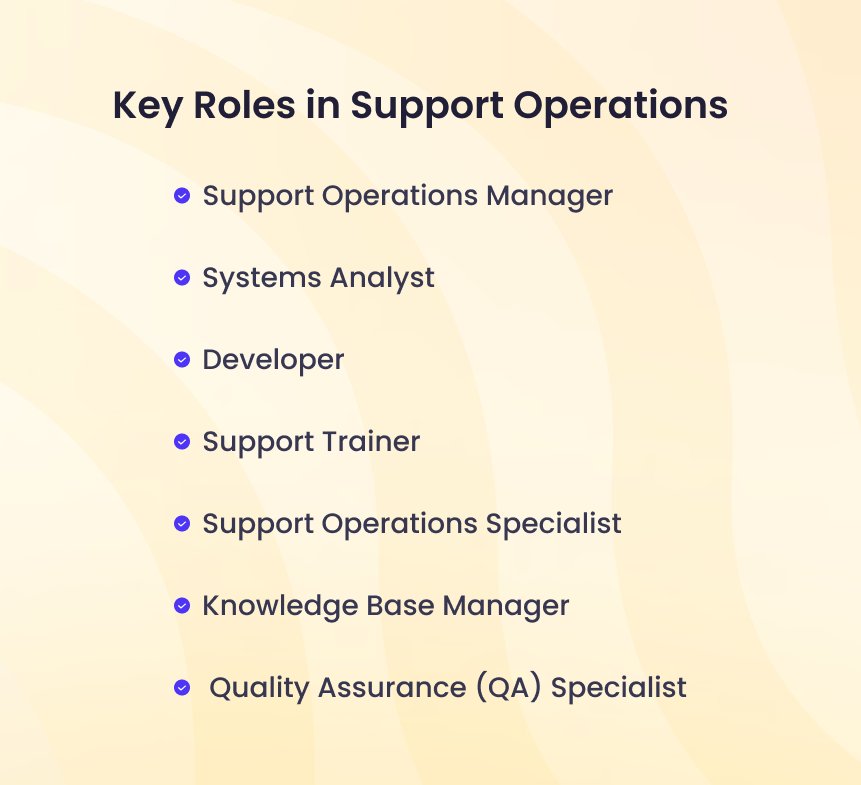
1. Support Operations Manager
Oversees the entire support operations team and is responsible for strategic planning and execution. Key responsibilities include:
- Managing agent schedules,
- Ensuring adherence to service level agreements (SLAs),
- Monitoring performance metrics to identify areas for improvement.
2. Systems Analyst
Maintains and improves internal systems. Responsibilities include:
- Troubleshooting technical issues
- Configuring information systems
- Supporting users with system-related queries
3. Developer
Responsible for maintaining applications that track customer interactions and developing internal tools. This role involves:
- Automating data collection
- Troubleshooting software issues
- Implementing new support service offerings
4. Support Trainer
Focuses on onboarding new customer service representatives (CSRs) and providing ongoing training. Responsibilities include:
- Develops training materials
- Conducts sessions on company protocols
- Teaches skills such as empathy in customer interactions
5. Support Operations Specialist
Works on improving internal processes and tools used by customer service teams. Responsible for:
- Engaging in data analysis to enhance operational workflows
- Assisting in designing new support channels
6. Knowledge Base Manager:
Develops and maintains a comprehensive knowledge base that includes troubleshooting guides, FAQs, and best practices for customers and support agents. Regularly updates content to reflect product changes, new features, and evolving customer needs.
7. Quality Assurance (QA) Specialist
Monitors and evaluates the quality of customer interactions across various channels (phone, email, chat, etc.). Conducts regular audits of support tickets to ensure they meet quality standards. Provides agents feedback on improving customer interactions and resolving potential service issues.
How to Build a Successful Support Operations Team: 4 Best Practices
1. Define clear objectives
Outlining objectives helps ensure that each team member understands their specific responsibilities. This minimizes overlaps and gaps in workflow. When each person in your team knows their goal, the team can operate smoothly, and you can allocate resources more efficiently.
For instance, the Operations Manager should focus on data analysis and reporting, while the Quality Assurance Specialist should monitor ticket quality. To ensure these objectives are achieved, you can set SMART (Specific, Measurable, Achievable, Relevant, Time-bound) goals for each role.
Here’s what it means:-
Specific: Clearly state what you want to achieve. Avoid vague goals. Instead of saying, “Improve response time,” specify, “Reduce first-response time for high-priority tickets to under 10 minutes.”
Measurable: Set metrics to track progress and success. For example, track the percentage of tickets resolved within a set time frame, like 90% resolved within 24 hours.
Achievable: Set ambitious but realistic goals. If your team resolves 50% of tickets within 24 hours, aim for 60% in the next quarter instead of 90%.
Relevant: Ensure the objective aligns with your business priorities and customer service goals. If customer satisfaction is prioritized, focus on reducing resolution time or improving agent training.
Time-bound: Set a deadline for achieving the goal. For example, achieve a 15% improvement in customer satisfaction ratings by the end of the next quarter.
2. Investing in the right technology
Support operations team is also responsible for ensuring that your customer service team has the right tech stack. They research about what tools to implement and how to do implement them. That’s because investing in the right tools helps streamline workflows and ensures that teams can provide quicker, more efficient, and personalized support.
These tools typically include::
- Helpdesk platforms: The key to delivering efficient customer service is centralizing all support requests. A helpdesk software helps you do that. Hiver, for example, turns your inbox into a powerful helpdesk. It helps centralize support requests, allowing teams to manage, prioritize, and track issues from a single platform.
- Collaboration tools: Support teams often must collaborate closely with other departments, such as sales, product, or logistics. Tools like shared inboxes, Slack, and other collaboration platforms help ensure collaborative communication. This is better than forwarding emails, as it reduces delays and miscommunication.
- Automation tools: Automation helps teams handle repetitive tasks efficiently. For instance, automating ticket assignment ensures incoming queries are routed to the right team members. This can be done based on the ‘sender’ or ‘keywords’ in the subject line. Therefore, this eliminates the need for manual sorting and ensures quicker response times.
- Knowledge bases: Support ops can reduce the load for frontline support agents by building an internal knowledge base. Customer service teams can refer to this knowledge base to access information without spending time searching through disparate resources.
- Customer Relationship Management (CRM) Systems: CRM systems help support teams track and manage customer interactions. By consolidating customer data—such as purchase history, past inquiries, preferences, and communication logs—CRMs provide a 360-degree view of each customer. For instance, if a customer contacts support about an issue with a product they purchased, the CRM can display details of their purchase, any previous support tickets, and their preferred communication channel.
- Analytics and Reporting Tools: The support ops team is also responsible for helping teams maintain customer service quality. They do this by tracking and analyzing performance metrics, including resolution time, first response time, and customer satisfaction scores (CSAT). They analyze this data to assess how well the customer service team is performing and identify areas for improvement.
Pro Tip: When handling escalations between different departments, relying on forwards and CCs might delay the resolution depending on the size of your team and the stakeholders involved. In that scenario, using Slack might be better, as explained in the subreddit below.

3. Equip your team with the right skills
A well-trained team is confident and prepared to handle dynamic challenges. Whether managing high volumes of queries or complex customer concerns, the right training will equip your team with the knowledge they need to deliver positive customer experiences.
But training doesn’t stop at onboarding—it’s an ongoing process that also includes:
- Regular skill-building sessions
- Updates on the latest tools and technologies
- Workshops on soft skills like communication and conflict resolution
Moreover, investing in gamification also boosts employee morale by turning routine tasks into engaging challenges. Incorporating elements like leaderboards, rewards, and badges can make even the most repetitive aspects of support operations feel fun and motivating.
Imagine implementing a points system where agents earn rewards for resolving tickets quickly, maintaining high customer satisfaction scores, or participating in training sessions. These points can be redeemed for prizes, recognition, or other incentives.
Recommended Reading:New Ways to Train in Customer Services
4. Hiring the right people
While tools and processes play a significant role, the people behind the scenes make the difference. Here’s what you should look for:
- Strong communication and collaboration skills: Support ops teams need to liaise between departments and provide actionable feedback to agents. So, look for people who can communicate clearly and collaborate cross-functionally with different teams (product, engineering, sales, etc.).
- Analytical skills: Look for candidates who can interpret data, track key performance metrics (e.g., CSAT, first response time),and identify trends or inefficiencies.
- Show Initiative: Look for proactive problem-solvers who can anticipate challenges, address them before they escalate, and continuously seek ways to improve operations.
ProTip: Having a team with members from diverse cultural backgrounds can be an added advantage. For example, Chloe Shill, Director of Operations at Flight CX, says, “I think the benefits of diverse teams are endless. For starters, diverse teams bring diverse perspectives—varied cultural backgrounds foster creativity and innovative solutions, ultimately allowing for better decision-making.”

How Hiver Simplifies Support Operations
Hiver equips support operations teams with collaboration, AI capabilities, analytics, and email management features. This empowers them to scale operations, lower costs, and gain valuable insights that enhance team productivity.
Let’s take a look at how Hiver does it:
Simplifying email management
Does your team use a group email such as support@ or info@ to manage support queries? Hiver can help you set up a shared inbox to manage group emails right from your Gmail or Outlook inbox.
Every incoming customer query can be assigned to a specific team member. It’s also possible to track the status of the query till resolution. Let’s say a customer reaches out about an urgent issue. You can assign the email to the right team member; everyone knows who’s responsible for the reply. No more back-and-forth to figure out who’s handling what!
Making email collaboration easy
Handling shared inboxes like support@ or info@ often come with challenges due to lack collaborative communication. Sometimes team members may struggle to stay aligned which causes delays or mixed responses that can frustrate customers. But if collaboration becomes easy, everyone will be on the same page and the time spent on the back and forth can be saved.
That’s where Hiver comes in. With Hiver, your team can assign emails as tasks, leave internal notes for context, and track progress—all within the inbox. If a customer emails about an urgent issue, one team member can respond while another adds key details as a note. This ensures everyone stays aligned. It also keeps responses clear, consistent, and timely, leading to happier customers.
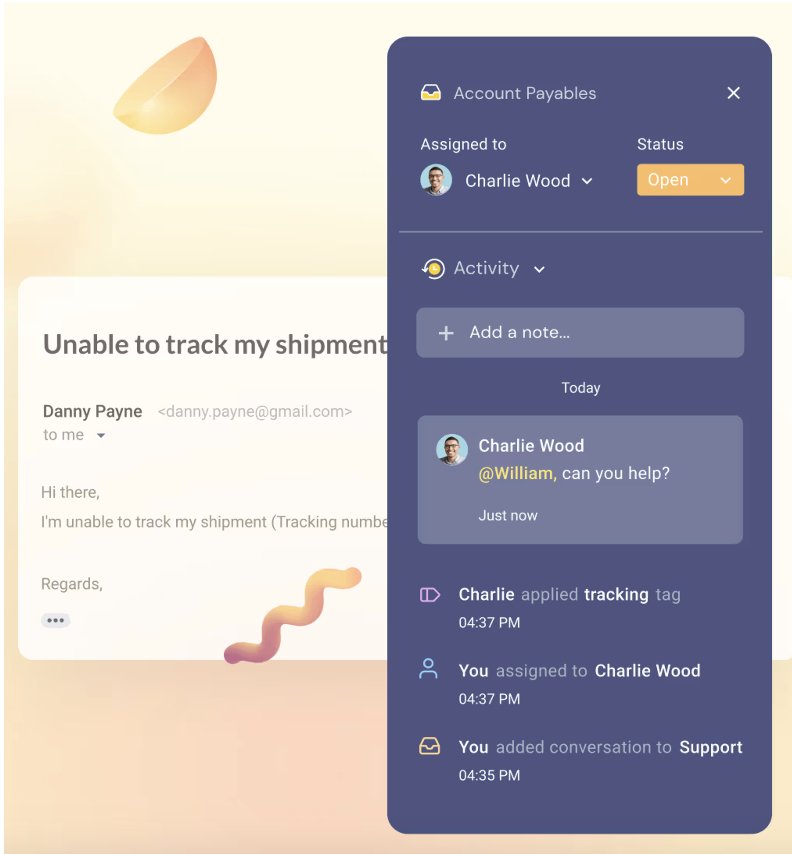
Did you know?Flexport, a full-service logistics company based in San Francisco, used to forward email subject lines on Slack whenever they had to assign an email to someone on the team. But after using Hiver, all they had to do was leave a note in the email rather than take things to Slack and build context there. This helped them resolve customer queries 50% faster.
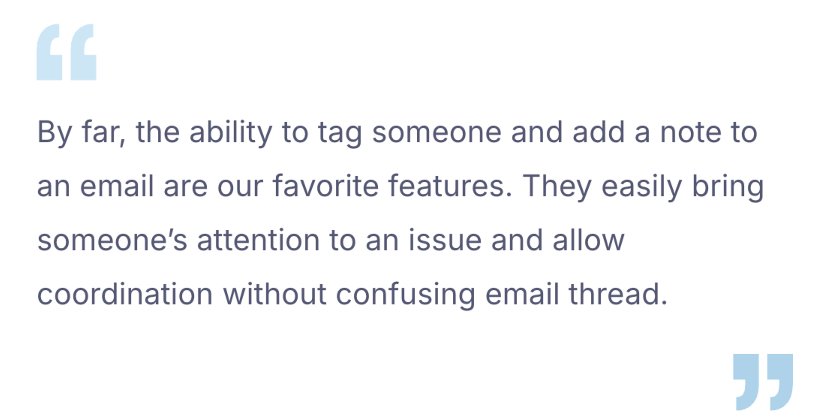
Saving time with automation and AI capabilities
With Hiver, repetitive tasks can be easily automated, freeing up time to focus on more complex operations. Instead of manually assigning emails to team members, you can automatically route them based on predefined rules. For example, an email mentioning “billing” can automatically be assigned to the billing team. This ensures faster response times and no email gets missed.
Additionally, you can set up rules to tag emails to automatically categorize or prioritize them. For instance, emails from VIP customers can be tagged as “High Priority” and moved to the top of the queue for immediate attention.
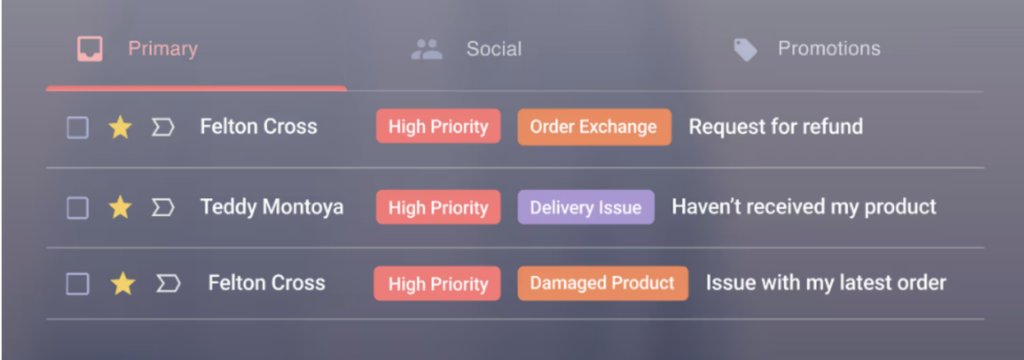
There are several other automations you can setup with Hiver.:
- Establish Service Level Agreements (SLAs) and automate reminders for pending tasks. For example, if a query hasn’t been responded to within the expected due date, Hiver will notify the assigned team members about the delay.
- Additionally, Harvey, the AI bot helps by automating simple tasks like getting email template suggestions and autoclosing emails that don’t need your attention. For example, closing conversations with ‘thank you’ responses.
- Another time consuming thing is going through each email to understand the context and provide a timely response. To help with this, Hiver’s AI Summarizar analyzes long email threads and concisely summarizes key points quickly. There’s no need to go through each email thread manually.
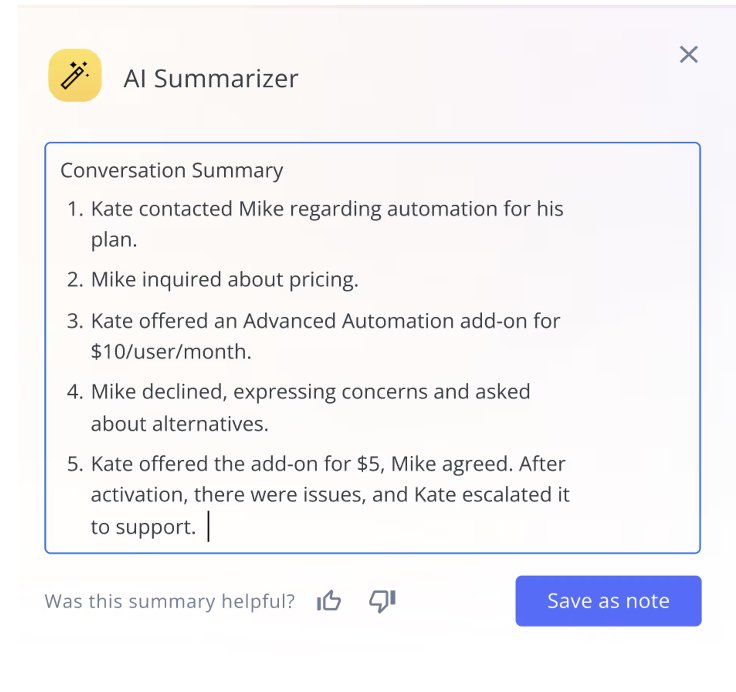
ProTip: Tagging incoming emails is useful not only for prioritizing tickets but also for tracking trends and communicating with other departments. This Reddit Thread explains it better.

Tracking performance using analytics
Without real-time data, it’s hard to know if your team is hitting key performance indicators (KPIs) such as — response time, resolution time, and customer satisfaction. This lack of visibility can lead to missed opportunities for improvement and hinder your team’s overall efficiency.
That’s why reports and analytics in Hiver offer a comprehensive dashboard where you can track performance metrics like average response times, resolution times, ticket volumes, and customer satisfaction scores. This visibility helps you understand where your team is excelling and where they might need extra support or training.
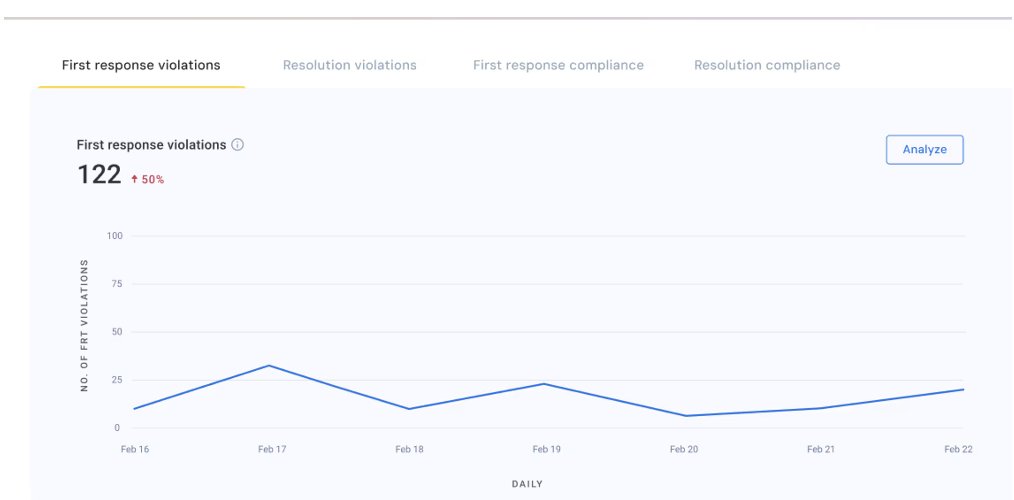
For instance, after analyzing the reports, you might find that most customer complaints revolve around a particular feature of your product. You can then flag this issue with the product team, reducing future support tickets and improving the overall customer experience.
Case in point: Cohere Health, a health-tech firm, could not visualize its team’s workload and how quickly they responded to and resolved requests. Using Hiver, the team can now export the data to analyze the trends in their client conversations and make data-driven decisions for the company.
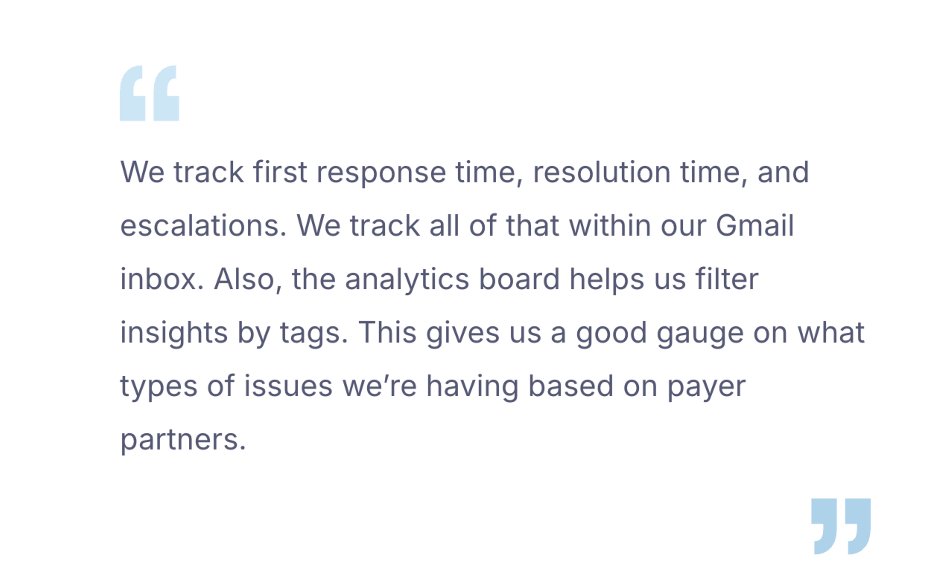
Optimize your support operations using Hiver
Support operations are the backbone of any customer-focused organization. They empower your support team to deliver exceptional service by ensuring smooth workflows, structured processes, and the right tools.
To truly master support operations, focus on these essentials:
- Define clear objectives: Know what success looks like for your support team and align your operations accordingly.
- Invest in the right technology: Equip your team with tools that simplify workflows and eliminate inefficiencies.
- Build a skilled team: Provide training and resources to help your team excel in their roles.
- Hire strategically: Bring on people who align with your company’s values and customer-first mindset.
And if you’re ready to take your support operations to the next level, consider tools like Hiver. It’s designed to help teams streamline ticket management from the comfort of their inbox.
By prioritizing these steps, you’ll not only enhance your team’s performance but also create a customer experience that stands out—every single time.


































